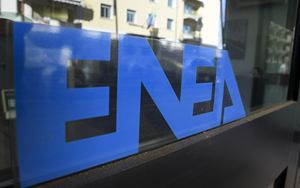(Finance) – One platform innovative for monitoring in real time of Central Mediterranean, but also an integrated laboratory for remote sensing, ocean models, chemical analyzes and marine property data. These are some of the results and activities conducted by AENEAS within the project Marine Hazard, financed with the PON measure “Research and competitiveness 2007-2013” and coordinated by Cnr. Specifically the platform WebGIS consists of a real one open source database, capable of managing environmental and geospatial information and monitoring different marine properties and parameters in real time, including those relating to natural and anthropogenic contamination. Furthermore, within the project, ENEA conducted activities relating to the analysis of sediments and satellite data; modeling studies on marine circulation; in situ and remote measurements of marine properties.
The platform was developed by the two ENEA laboratories “Observations and measures for the environment and climate” And “Protection of critical infrastructures“, in collaboration with the Cnr, as part of the activities aimed at developing an integrated laboratory for remote sensing: in addition to the data from in situ measurements and remote sensing coming from the ENEA Observatories of Lampedusa and the Cnr of Cape Granitola (Sicily), the maxi-laboratory is able to receive and process information relating to Earth Observation from the “Copernicus Marine Environment”, and to make a multi-year archive of daily satellite data available to the scientific community and institutions, which can be consulted and downloaded.
“In particular, ENEA with the Lampedusa Climate Observatory provided a fundamental contribution to the development of the open source WebGIS system, which made it possible to manage the temporal evolution of events and make continuously updated information available to the institutions,” underlines Giorgio Di Sarra, researcher at the ENEA Laboratory of Observations and Measurements for the Environment and Climate. “Through the integration of the measurements carried out at the Lampedusa Laboratory and by satellite, it was possible to study some of the phenomena that impact the sea and coasts of the Mediterranean such as the heat waves which in 2022-23 were exceptional in terms of duration and intensity or the intense rainfall last February in south-eastern Sicily”, concludes Di Sarra.
The Remote Sensing Laboratory is structured in various ways components: from data acquisition and integration center to reference laboratory for the characterization, instrumental configuration and verification of Earth Observation data; from the development of new platforms and new observation systems through the creation and characterization of new sensors, to the integration of observation techniques from Earth and Space into the flexible and expandable webGIS system; up to the implementation of new algorithms and methods for the characterization of the marine environment.
“One of the great advantages of the WebGIS platform lies in the ability to be used by different users and for specific purposes, depending on objectives and skills”, highlights Maurizio Pollino, head of the ENEA Critical Infrastructure Protection Laboratory. “For example, it is possible to easily insert your own data into the system and integrate it with that of validated satellite observations. This type of functionality is particularly useful for users of environmental agencies and local administrations and for this reason its application is constantly being improved with new documents and functions”, concludes Pollino.
It’s not all. Thanks to a innovative ocean modeldeveloped by ENEA, which realistically reproduces the surface circulation of the Mediterranean, the researchers carried out a very high resolution study of the circulation models on the underwater volcano “Palinuro”, about 65 kilometers from the Cilento coast. The results of the analysis have provided important indications for activities to mitigate the effects resulting from extraction of mineral resources in the marine environment. The activities were conducted by a team made up of experts from the two ENEA Divisions “Models and technologies for the reduction of anthropogenic impacts and natural risks” and “Protection and enhancement of the territory and natural capital”.
ENEA also contributed to the development of a mobile and integrated technology platform reclamation of marine sediments, coming from coastal areas contaminated by metals and organic substances, such as mercury, arsenic and hydrocarbons. The sediment characterization activities, development of analytical methods and validation of the results were conducted in the pilot areas of the contaminated sites of Bagnoli (Naples) and Augusta (Syracuse).
Regarding the restoration of degraded seabed, ENEA has conducted wave motion characterization studies in the Gulf of Palermo, an area involved in a restoration and reforestation intervention with Posidonia oceanica. In fact, as part of the project, an innovative biodegradable plastic system will be created on the seabed of the area for fixing cuttings of Posidonia oceanica, with the aim of promoting their rooting, growth and natural development dynamics.
In addition to ENEA and Cnr, INGV, INFN, the Experimental Zooprophylactic Institute of Sicily “A. Mirri”, Anton Dohrn Zoological Station, CoNISMa and the companies Leonardo, Orion, Enviroconsult, Mater and Cericit.
